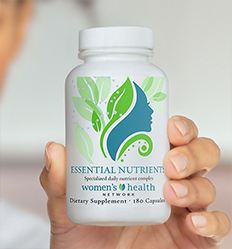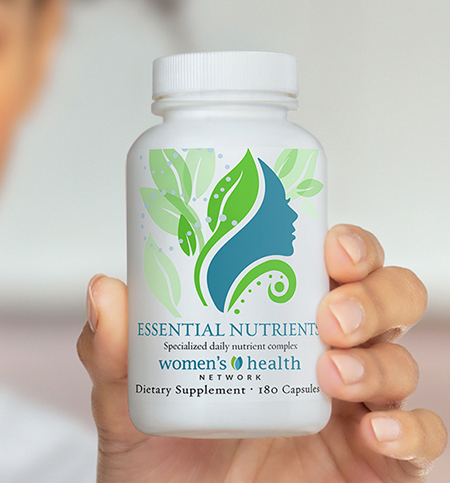Authored by Dr. Susan E. Brown, PhD
Any time you read a food label, you can get a lot of information about what you’re going to eat. But there is also some misinformation too, especially for women. Here’s how to know what the food label is really telling you — or what it’s leaving out.

What your food label isn’t telling you
The U.S. Food and Drug Administration (FDA) requires that the ingredients are listed “in order of predominance by weight,” meaning that whatever weighs the most in the package — including water — is listed first, whatever is second most by weight is listed second, and so on. In addition, the ingredients label includes information about:
- Additives used to keep the food fresh or change its color have to be listed. If they’re preservatives, they have to describe what their function is (such as “to protect flavor and freshness”).
- Companies must declare whether there is any possibility that the food contains one of eight foods considered to be “major food allergens.” These are milk, eggs, fish, crustacean shellfish, tree nuts, wheat, peanuts and soybeans. These foods are responsible for over 90% of food allergies.
But here’s what manufacturers can leave off the label:
- Manufacturers don’t have to specifically declare any other allergens beyond the list of major food allergens. So if you’re allergic to corn, you need to be extremely careful to read ALL the ingredients on the list to ensure the product doesn’t have corn starch or other corn byproducts in it. And be aware that not all corn byproducts are called “corn —”. “Food starch,” for example, is often just plain old corn starch.
- Food companies are not required by either the FDA or the USDA to tell you if their products are grown using pesticides, herbicides or antimicrobial drugs. This is concerning for women since chronic exposure to pesticides and other endocrine-disrupting toxins can contribute to hormonal issues such as estrogen dominance. Food manufacturers are also off the hook from telling consumers if foods are treated with disinfectants, radiation or other chemicals during processing.
- Food labels are not required to disclose genetically modified ingredients. Some food products are labeled GMO-free to help consumers make informed choices.
Why nutrition facts are misleading
Since conventional medicine takes a “calories in, calories out” approach to weight management, the caloric input of the food is given the most prominence in the label.
Serving size is second — the goal being to help consumers understand how much energy they’re putting into their bodies when they consume a specific amount of food. Fat content, cholesterol, sodium, carbohydrates (including fiber) and protein are all listed prominently. Again, these are all nutrients that conventional medicine has considered important in the past. And specific vitamins and minerals present in insignificant amounts (meaning, more than 1% by weight of the total) are listed at the bottom.
Next to each nutrient is a percentage indicating what proportion of the “recommended daily total value” (DV) the contents of the package represent. But the assumption of the percentages is that everyone looking at the package needs — and gets — the same values per day.
Which is absolutely ridiculous!
Most of these DVs are based on the needs of men, whose daily requirements for all nutrients are generally higher than women’s. As an example, let’s look at calories. The label states that the base DV for calories is 2,000. For women, especially, this base DV is misleading. Most women over the age of 25 only need 2,000 calories if they’re what the USDA considers to be “moderately active,” defined as “physical activity equivalent to walking about 1.5 to 3 miles per day at 3 to 4 miles per hour, in addition to the activities of independent living.”
And if you’re over 50, the requirement goes down to 1,800 per day, even for moderately active women. Women over 50 who are “sedentary” only need 1,600 calories per day. If you’re a woman over 50 and not exercising daily, your DVs are probably going to be lower and the percentages for each nutrient will therefore be higher.
Another problem: the DVs established by the USDA often don’t reflect current science. The saturated fat content, for example, is on the label because saturated fat was long held to be the key culprit in heart disease. But more recent science has called this into question.
Food labels are far from perfect. Their information is limited. They emphasize some nutritional info that’s outmoded or that’s been debunked by current research. And the specifics are based on men’s needs, not women’s. All of this puts us in danger of not getting the good nutrition that we actually need! At most, food labels offer women a little bit of guidance toward finding healthier options — but you need to know how to look beyond the label.
References and further reading
Barton A, “Kelp Is On the Way,” The Globe & Mail December 9, 2016, https://www.theglobeandmail.com/life/food-and-wine/food-trends/eat-seaweed-for-the-health-benefits—but-dont-overdoit/article33281211/
Cleveland Clinic. “Soy Foods: Benefits of Soy,” December 2013, https://my.clevelandclinic.org/health/articles/17491-soy-foods/benefits-of-soy
Egan S, “How to Read a Food Label,” The New York Times, https://www.nytimes.com/guides/well/how-to-read-a-food-label.
The Environmental Working Group, “Dirty Dozen: EWG’s 2018 Shopper’s Guide to Pesticides in Produce,” https://www.ewg.org/foodnews/dirty-dozen.php. Hall M, “Fiber Facts
About Cereal,” Today’s Dietitian 2012;14(12):30. Harvard T.H. Chan School of Public
Health, “Saturated fat, regardless of type, linked with increased heart disease risk.” https://www.hsph.harvard.edu/nutritionsource/2016/12/19/saturated-fat-regardless-of-type-found-linked-with-increased-heart-disease-risk/
Martino JV, Van Limbergen J, Cahill LE, “The Role of Carrageenan and Carboxymethylcellulose in the Development of Intestinal Inflammation,”
Frontiers in Pediatrics, 01 May 2017, https://doi.org/10.3389/fped.2017.00096 NicholsH, “Saturated fat may not increase heart disease risk after all,”
Medical News Today December 27, 2016, https://www.medicalnewstoday.com/articles/314693.php
US Department of Agriculture, “Organic Labeling Standards,” https://www.ams.usda.gov/grades-standards/organic-labeling-standards.
US Food and Drug Administration, “A Food Labeling Guide: Guidance for Industry,”January 2013, www.fda.gov/FoodLabelingGuide










